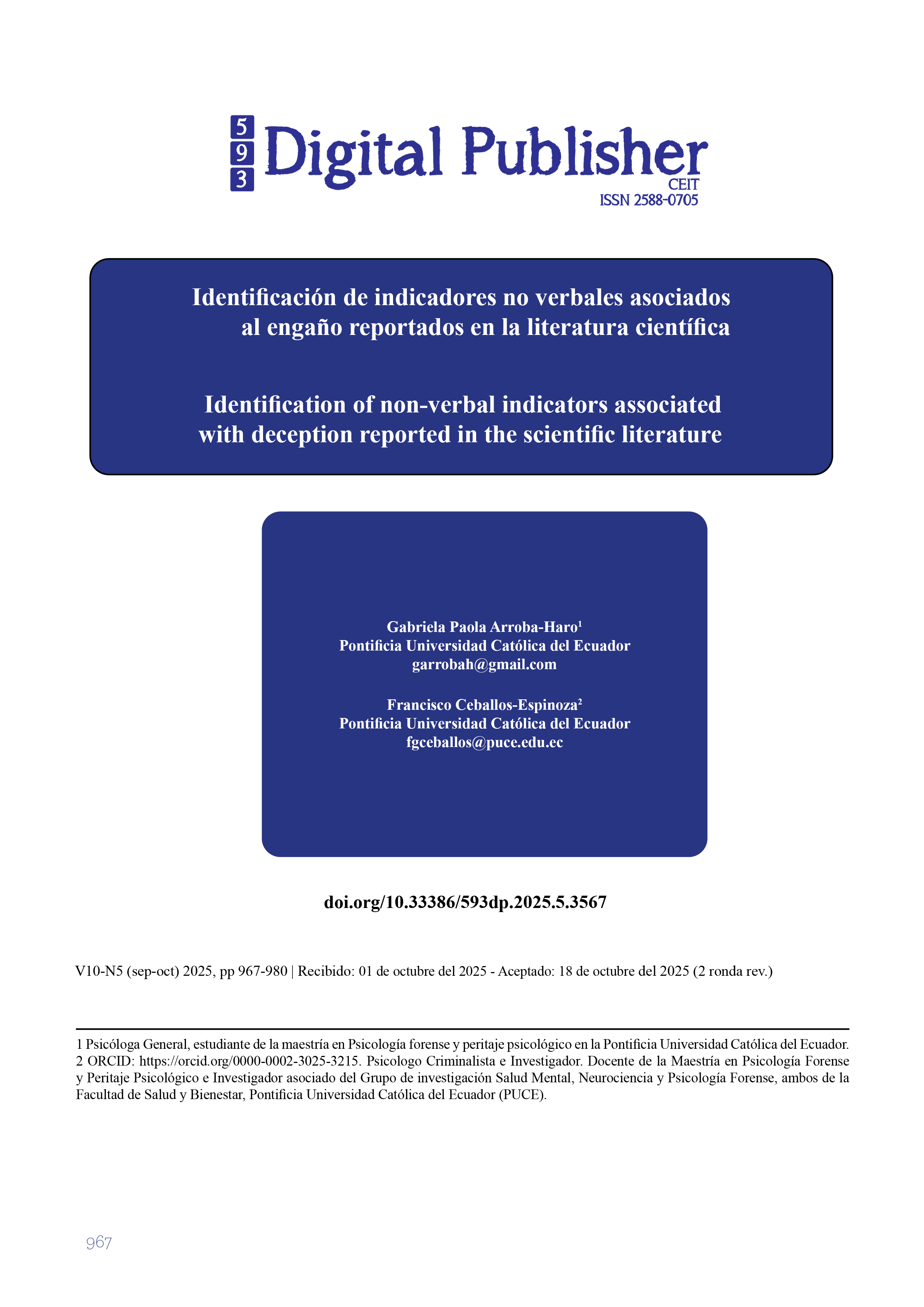Identificación de indicadores no verbales asociados al engaño reportados en la literatura científica
Contenido principal del artículo
Resumen
Este artículo de revisión sistemática, basado en la literatura científica entre 2005 y 2025, aborda la identificación de indicadores no verbales asociados al engaño en contextos forenses y de investigación criminal. Debido a que se ha evidenciado en varios estudios la ineficacia de la intuición (54% de precisión) y la confusión con el estrés, junto a la falta de realismo en estudios de laboratorio, resaltando la importancia de analizar indicadores con mayor precisión. La revisión sistemática siguió el proceso PRISMA 2020, evaluando estudios empíricos con la herramienta MMAT.
Los hallazgos revelan la ausencia de indicadores no verbales universales de engaño, ya que las señales son altamente contextuales y culturales. Los más reportados son expresiones faciales, lenguaje corporal y señales paralingüísticas. Enfoques multimodales que integran ML, FACS y observación humana reportan precisiones elevadas (78–90 %) según revisiones recientes (Constâncio et al., 2023; Chen et al., 2023), aunque estos valores dependen del dataset y contexto, sin generalizarse a entornos forenses reales. Se recomienda un modelo integrado, multimodal y culturalmente sensible, con protocolos estandarizados que distingan engaño de ansiedad, para mayor fiabilidad judicial.
Descargas
Detalles del artículo

Esta obra está bajo una licencia internacional Creative Commons Atribución-NoComercial-CompartirIgual 4.0.
1. Derechos de autor
Las obras que se publican en 593 Digital Publisher CEIT están sujetas a los siguientes términos:
1.1. 593 Digital Publisher CEIT, conserva los derechos patrimoniales (copyright) de las obras publicadas, favorece y permite la reutilización de las mismas bajo la licencia Licencia Creative Commons 4.0 de Reconocimiento-NoComercial-CompartirIgual 4.0, por lo cual se pueden copiar, usar, difundir, transmitir y exponer públicamente, siempre que:
1.1.a. Se cite la autoría y fuente original de su publicación (revista, editorial, URL).
1.1.b. No se usen para fines comerciales u onerosos.
1.1.c. Se mencione la existencia y especificaciones de esta licencia de uso.
Citas
Blandón-Gitlin, I., López, R. M., Masip, J., & Fenn, E. (2017). Cognición, emoción y mentira: Implicaciones para detectar el engaño. Anuario de Psicología Jurídica, 27(1), 95–106. https://doi.org/10.1016/j.apj.2017.02.004
Bond, C. F., Jr., & DePaulo, B. M. (2006). Accuracy of deception judgments. Personality and Social Psychology Review, 10(3), 214–234. https://doi.org/10.1207/s15327957pspr1003_2
Carvajal Builes, J., Gómez Durán, E. L., & Barreto, I. (2021). Comportamiento visual y engaño: Una revisión sistematizada. Anuario de Psicología, 51, 120–129. https://doi.org/10.1344/anpsic2021.51.14
Catlin, M. K., Meissner, C. A., & Viljoen, J. L. (2024). Interview and interrogation methods and their effects on true and false confessions: A systematic review and meta-analysis. Campbell Systematic Reviews, 20(2), e1436. https://doi.org/10.1002/cl2.1441
Chen, X., Wang, X., Spitzley, L., & Nunamaker, J. (2023). Trust and deception with high stakes: Evidence from the friend or foe dataset. Decision Support Systems, 173, 113997. https://doi.org/10.1016/j.dss.2023.113997
Cheng, K. H. W., & Broadhurst, R. (2005). The detection of deception: The effects of first and second language on lie detection ability. Psychiatry, Psychology and Law, 12(1), 107–118. https://doi.org/10.1375/pplt.2005.12.1.107
Constâncio, A. S., Tsunoda, D. F., Silva, H. F. N., Silveira, J. M., & Carvalho, D. R. (2023). Deception detection with machine learning: A systematic review and statistical analysis. PLOS ONE, 18(2), e0281323. https://doi.org/10.1371/journal.pone.0281323
Dong, L. D., Batool, K., Cameron, C. A., & Lee, K. (2025). Smiling, face covering, and rhythmic body rocking in children who cheat versus do not cheat. Journal of Experimental Child Psychology, 249, 106119. https://doi.org/10.1016/j.jecp.2024.106119
Dunbar, N. E., Burgoon, J. K., Chen, X., Wang, X., Ge, S., Huang, Q., & Nunamaker, J. (2023). Detecting ulterior motives from verbal cues in group deliberations. Frontiers in Psychology, 14, 1166225. https://doi.org/10.3389/fpsyg.2023.1166225
Elbatanouny, H., Roken, N. A., Hussain, A., Khan, W., Khan, B., & Almajali, E. (2025). A comprehensive analysis of deception detection techniques leveraging machine learning. Expert Systems with Applications, 283, 127601. https://doi.org/10.1016/j.eswa.2025.127601
Fan, Y., Fan, H., Zhang, F., & Wang, Z. (2025). Large language model meets chaos: A new deep learning model for fake review detection. International Journal of Information Management, 75, 102882. https://doi.org/10.1016/j.elerap.2025.101521
Fernandes, S. V., & Ullah, M. S. (2022). A comprehensive review on features extraction and features matching techniques for deception detection. IEEE Access, 10, 28233–28266. https://doi.org/10.1109/ACCESS.2022.3157821
Granhag, P. A., Vrij, A., & Verschuere, B. (2014). Detecting deception: Current challenges and cognitive approaches. In Wiley Handbook of Psychology of Investigation (Vol. 2, pp. 1–25). John Wiley & Sons. https://doi.org/10.1002/9781118510001
Gullapalli, A. R., Anderson, N. E., Yerramsetty, R., Harenski, C. L., & Kiehl, K. A. (2021). Quantifying the psychopathic stare: Automated assessment of head motion is related to antisocial traits in forensic interviews. Journal of Experimental Social Psychology, 206, 105096. https://doi.org/10.1016/j.jrp.2021.104093
Hong, Q. N., Pluye, P., Fàbregues, S., Bartlett, G., Boardman, F., Cargo, M., ... Vedel, I. (2018). Mixed Methods Appraisal Tool (MMAT), version 2018: User guide. McGill University. https://doi.org/10.3233/EFI-180221
Jin, J., Zhu, X., Lian, W., & Fan, L. (2025). Unraveling the neurophysiological underpinnings of social anxiety through body language: An ERP study. Comprehensive Psychiatry, 125, 152617. https://doi.org/10.1016/j.comppsych.2025.152617
Kwan, M., Chow, K.-P., Law, F., & Lai, P. (2008). Reasoning about evidence using Bayesian networks. In I. Ray & S. Shenoi (Eds.), Advances in Digital Forensics IV (Vol. 285, pp. 275–289). https://doi.org/10.1007/978-0-387-84927-0_22
Levine, T. R. (2021). Distrust, false cues, and deception detection accuracy below the probable: Commentary on Stel et al. (2020) and other reflections on (un)conscious lie detection from the truth-default theory perspective. Frontiers in Psychology, 12, 642359. https://doi.org/10.3389/fpsyg.2021.642359
Levine, T. R. (2022). Truth-default theory and the psychology of lying and deception detection. Current Opinion in Psychology, 47, 101380. https://doi.org/10.1016/j.copsyc.2022.101380
Markowitz, D. M., Hancock, J. T., Woodworth, M. T., & Ely, M. (2023). Contextual considerations for deception production and detection in forensic interviews. Frontiers in Psychology, 14, 1134052. https://doi.org/10.3389/fpsyg.2023.1134052
Murphy, G., & Greene, C. M. (2023). Conducting ethical misinformation research: Deception, dialogue, and debriefing. Current Opinion in Psychology, 54, 101713. https://doi.org/10.1016/j.copsyc.2023.101713
Noriega, M. (2020). The application of artificial intelligence in police interrogations: An analysis addressing the proposed effect AI has on racial and gender bias, cooperation, and false confessions. Futures, 117, 102510. https://doi.org/10.1016/j.futures.2019.102510
Nortje, A., & Tredoux, C. (2019). How good are we at detecting deception? A review of current techniques and theories. South African Journal of Psychology, 49(4), 491–504. https://doi.org/10.1177/0081246318822953
Peters, M. D., Godfrey, C., McInerney, P., Khalil, H., Larsen, P., Marnie, C., Pollock, D., Tricco, A. C., & Munn, Z. (2022). Best practice guidance and reporting items for the development of scoping review protocols. JBI Evidence Synthesis, 20(4), 953–968. https://doi.org/10.11124/jbies-21-00242
Porter, S., Doucette, N. L., Woodworth, M., Earle, J., & MacNeil, B. (2008). Halfe the world knowes not how the other halfe lies: Investigation of verbal and non-verbal signs of deception exhibited by criminal offenders and non-offenders. Legal and Criminological Psychology, 15(2), 287–300. https://doi.org/10.1348/135532507X186653
Sporer, S. L., & Schwandt, B. (2006). Paraverbal indicators of deception: A meta-analytic synthesis. Applied Cognitive Psychology, 20(4), 421–446. https://doi.org/10.1002/acp.1190
Sporer, S. L., & Schwandt, B. (2007). Moderators of nonverbal indicators of deception: A meta-analytic synthesis. Psychology, Public Policy, and Law, 13(1), 1–34. https://doi.org/10.1037/1076-8971.13.1.1
Sua Rozo, A. A., & Julio Quintero, M. A. (2023). Aspectos implicados en el engaño partiendo de métodos de análisis del lenguaje no verbal. Contextos, 27, 3–13. Universidad de Pamplona. DOI:10.13140/RG.2.2.22181.27364
Tong, H., & Zhou, X. (2024). Cross-cultural differences in using nonverbal behaviors to identify indirect replies. Journal of Nonverbal Behavior, 48(3), 323–344. https://doi.org/10.1007/s10919-024-00454-z
Vitale, I. V. (2021). Facial Action Coding System applied to criminal investigations: The analysis of a homicide case in Southern Italy. International Annals of Criminology, 61(1), 11–22. https://doi.org/10.1017/cri.2021.7
Vrij, A., & Fisher, R. P. (2019). Nonverbal cues to deception in Title IX investigations. Journal of Applied Research in Memory and Cognition, 8(4), 417–419. https://doi.org/10.1016/j.jarmac.2019.07.006
Vrij, A., Granhag, P. A., & Leal, S. (2010). How can you tell if someone is lying? A cognitive approach to lie detection. Current Directions in Psychological Science, 20(1), 28–32. https://doi.org/10.1177/0963721410391245
Walczyk, J. J., Igou, F. P., Dixon, A. P., & Tcholakian, T. (2013). Advances in lie detection by inducing cognitive load in liars: A review of relevant theories and techniques guided by lessons learned from polygraph-based approaches. Frontiers in Psychology, 4, 14. https://doi.org/10.3389/fpsyg.2013.00014



